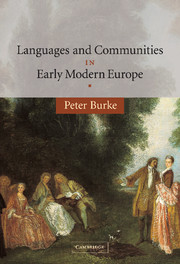Book contents
- Frontmatter
- Contents
- Acknowledgements
- Chronology 1450–1794
- Prologue: communities and domains
- 1 ‘Speak, that I may see thee’: the discovery of language in early modern Europe
- 2 Latin: a language in search of a community
- 3 Vernaculars in competition
- 4 Standardizing languages
- 5 Mixing languages
- 6 Purifying languages
- Epilogue: languages and nations
- Appendix: languages in Europe 1450–1789
- Bibliography
- Index
Prologue: communities and domains
Published online by Cambridge University Press: 07 December 2009
- Frontmatter
- Contents
- Acknowledgements
- Chronology 1450–1794
- Prologue: communities and domains
- 1 ‘Speak, that I may see thee’: the discovery of language in early modern Europe
- 2 Latin: a language in search of a community
- 3 Vernaculars in competition
- 4 Standardizing languages
- 5 Mixing languages
- 6 Purifying languages
- Epilogue: languages and nations
- Appendix: languages in Europe 1450–1789
- Bibliography
- Index
Summary
The principal aim of this book is to reflect on the changing relations between language and community, or, more exactly, between languages and communities in the plural, in Europe and other areas in which European languages were spoken, from the invention of printing to the French Revolution. This is not a general survey of the history of the languages of Europe in the early modern period so much as a series of linked essays (originally lectures) on a few major strands in that history.
Today, language is a topical subject. Indeed, the year 2001 was officially declared the ‘European Year of Language’. There should be little need to remind anyone of the links between language and politics, or, better, the entanglement of language with politics at a time when phrases such as ‘language rights’ and ‘identity politics’ have recently entered our everyday speech. At a time of involvement, this book makes an attempt at detachment or distanciation, reculer pour mieux sauter.
Why should a cultural historian write about language? Why not leave the topic to the linguists? For one thing, because language is always a sensitive indicator – though not a simple reflection – of cultural change. In this respect, the history of linguistic borrowings (below, pp. 111ff.) is suggestive. What English borrowed from Italian in the sixteenth and seventeenth centuries, especially artistic terms such as aria, chiaroscuro, fresco and piazza, tells us something about both cultures, about Italian leadership in the arts and about English interest in catching up.
- Type
- Chapter
- Information
- Languages and Communities in Early Modern Europe , pp. 1 - 14Publisher: Cambridge University PressPrint publication year: 2004

